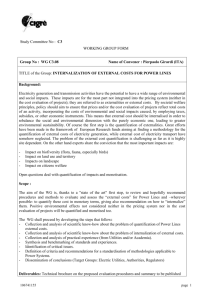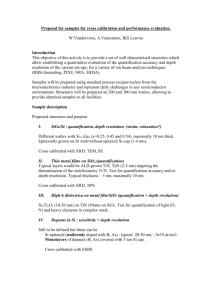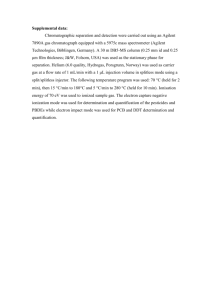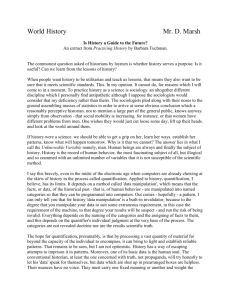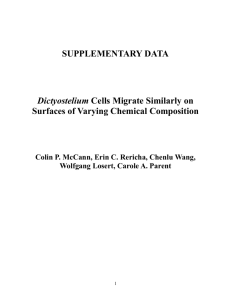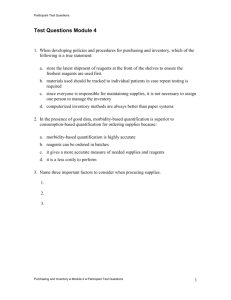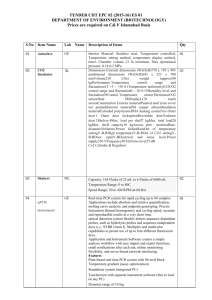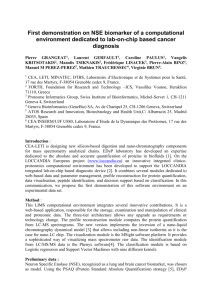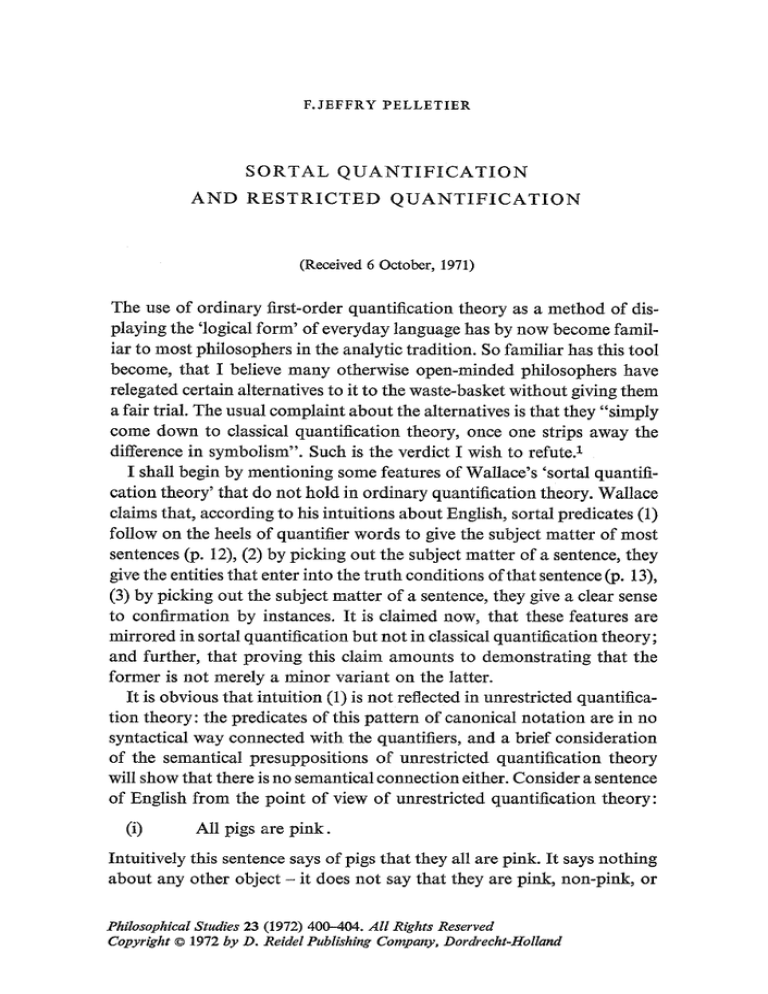
F.JEFFRY PELLETIER
SORTAL QUANTIFICATION
AND RESTRICTED QUANTIFICATION
(Received 6 October, 1971)
The use of ordinary first-order quantification theory as a method of displaying the 'logical form' of everyday language has by now become familiar to most philosophers in the analytic tradition. So familiar has this tool
become, that I believe many otherwise open-minded philosophers have
relegated certain alternatives to it to the waste-basket without giving them
a fair trial. The usual complaint about the alternatives is that they "simply
come down to classical quantification theory, once one strips away the
difference in symbolism". Such is the verdict I wish to refute.1
I shall begin by mentioning some features of Wallace's 'sortal quantification theory' that do not hold in ordinary quantification theory. Wallace
claims that, according to his intuitions about English, sortal predicates (1)
follow on the heels of quantifier words to give the subject matter of most
sentences (p. 12), (2) by picking out the subject matter of a sentence, they
give the entities that enter into the truth conditions of that sentence (p. 13),
(3) by picking out the subject matter of a sentence, they give a clear sense
to confirmation by instances. It is claimed now, that these features are
mirrored in sortal quantification but not in classical quantification theory;
and further, that proving this claim amounts to demonstrating that the
former is not merely a minor variant on the latter.
It is obvious that intuition (1) is not reflected in unrestricted quantification theory: the predicates of this pattern of canonical notation are in no
syntactical way connected with the quantifiers, and a brief consideration
of the semantical presuppositions of unrestricted quantification theory
will show that there is no semantical connection either. Consider a sentence
of English from the point of view of unrestricted quantification theory:
(i)
All pigs are pink.
Intuitively this sentence says of pigs that they all are pink. It says nothing
about any other object - it does not say that they are pink, non-pink, or
Philosophical Studies 23 (1972) 400-404. All Rights Reserved
Copyright 9 1972 by D. Reidel Publishing Company, Dordrecht-Iarolland
SORTAL AND RESTRICTED QUANTIFICATION
401
even that the predicate 'pink' can be meaningfully applied to them. It is
'about' and only 'about' pigs3 A representation of (i) in unrestricted
quantification theory is
(ii)
(x) (Gx = Kx).
But if we consider how this is interpreted, we find that the subject matter
of our sentence is no longer just pigs, but everything in the domain - everything that the bound variables can take as values. But this is more like
saying
(iii)
Everything is such that if it is a pig, it is pink.
One can argue as to whether (iii) makes sense at all (I suppose Wallace
would say it did not), but whatever sense it makes is surely different from
that of (i).
Since 'pig' in English is a sortal (which I have represented by 'G'), (i)
becomes, in Wallace's notation,
(iv)
(Ax) [G] (Kx).
The quantifier phrase (up to the dosing square bracket) is supposed to
reflect our intuition (1) in the canonical notation. To see if this intuition is
really reflected we must look at the characterization of (logical) truth,
i.e., we must look at how intuition (2) is reflected. Wallace (p. 13) says
Applying the definition of truth for a given language to a sentence of that language
gives the truth-conditions for the sentence. It is reasonable to say that the sentence is
about the entities - other than 'machinery' entities like assignments,variables, formulas
-
which are involved in its truth conditions.
He procedes to make this 'involved' precise. An assignment involves a
certain entity if and only if it has that entity as a value for some argument.
The truth conditions for a sentence involve an entity if and only if they
bring into play an assignment that involves that entity. Now, the truth
conditions of unrestricted quantification theory call into play every assignment and therefore involve every entity that the bound variables can
take as values. Thus the truth conditions of (ii) involve cats, elephants,
planets, numbers, etc., whereas our intuition (2) tells us it should only involve pigs. The present question is: can there be any way sortal quantification theory can give a characterization of truth such that the only entities
involved in the truth conditions for (iv) are pigs ? Wallace says in his last
sentence: "The truth-conditions for a given sentence (of sortal quantifica-
402
F. J E F F R Y P E L L E T I E R
tion theory) involve a given entity if and only if an assignment that involves that entity falls under some sortal predicate which occurs as a subject of a sentence in the truth conditions". If we look at the definition of
truth given by Wallace on pp. 12-13, we see that since a sentence is true if
and only if the empty assignment satisfies it, the only entities that enter
into the truth conditions of (iv) are those that fall under the sortal which
is the subject of the sentence, namely pigs. We should note that no analogous claim for unrestricted quantification theory can be formulated.
Intuitively, to confirm (i) by instances, one need only look at pigs and see
whether or not they are pink. We also intuitively believe that whatever
confirms one sentence will equally confirm a logically equivalent sentence.
Taken together, these two intuitions pose the 'paradox of confirmation'
for unrestricted quantification theory, since
(v)
(x) ( - K x = - a x )
is equivalent to (ii), and yet (v) would seem to be confirmed by looking at
non-pink things and seeing whether or not they are non-pigs. As long as
one holds to these two intuitions about confirmation, there is no way out
of the 'paradox' for unrestricted quantification theory) However, given
the characterization of 'entities entering into the truth conditions of (iv)',
we see that these two intuitions are quite well accommodated by sortal
quantification theory. Since only pigs enter into the truth conditions of
(iv), we need only see whether each of them satisfies 'Kx', i.e., see of them
whether or not they are pink. The reason for the difference here between
sortal quantification theory and unrestricted quantification theory is, of
course, that the English sentence for which (v) is the canonical representation in unrestricted quantification theory has no canonical counterpart in
sortal quantification theory, since 'non-pink thing' is not a sortal, and a
fortiori cannot be equivalent to (iv). Thus sortal quantification theory does
not countenance the 'paradox of confirmation'.
Of course, some apparent alternatives to ordinary quantification theory
do turn out to be nothing more than classical quantification theory, once
the notational differences are done away with. The most widely-known
such variant is what is traditionally called 'restricted quantification theory'. a Herein we can 'restrict' the variables of quantification to just those
that satisfy a certain formula. So, for example, if we wish to 'restrict' our
variables of quantification to those entities which satisfy ~, we might say
SORTAL AND RESTRICTED Q U A N T I F I C A T I O N
403
of these ~'s that they satisfy ~k thusly:
(vi)
(~x~)
~,.
Restricted quantification theory, when presented simply, as done here, or
when presented completely, as in Hailperin, is acknowledged to be merely
a variant on unrestricted (ordinary) quantification theory (see Hailperin
pp. 19, 29). This is so because (a) there is an automatic syntactical transform from (vi) to
(vii)
(y) (~' ~ ~')
of ordinary quantification theory, and (b) the truth conditions and confirmatory instances of (vi) and (vii) are identical. This, then, is the reason (or
one of the reasons) that restricted quantification theory is, but sortal
quantification theory is not, a mere notational variant on ordinary quantification theory.
I suggest that what Bacon (cited in Note 1 above) and others who believe sortal quantification theory to be somehow like restricted quantification when the difference in symbolism is stripped away have in mind is
merely this: if a sentence of English is represented in sortal quantification
theory as
(viii)
(Ax) [GI (Kx)
then it would be represented in restricted quantification theory as
(ix)
(~xGx)(K~xGx).
But this is of course not to say that the two theories are the same. ff it did,
then any two theories which treated of the same subject matter would be
identical - e.g., propositional logic and predicate logic.
I have said nothing about Quine's charge about Belnap's new logic of
quantification. It is, however, a simple matter to follow the same argument as presented in this paper and show that Belnap's logic has semantical presuppositions that cannot be mirrored in restricted quantification
theory. I hope, therefore, that philosophers will stop making the elementary mistake attributed to Bacon above, and evaluate each new 'pattern of
canonical notation' on its ability to mirror features of natural languages.
At least one should be aware that not every 'restriction' in a quantification
theory is a restriction in the normal sense.
Department of Philosophy
University of Alberta
404
F. JEFFRY P E L L E T I E R
NOTES
t It is difficult to find this charge in print. I have heard it made in conversation many
times, but the only two places in print that I have seen it are: W. V. Quine, 'Abstract of
Comments on Belnap's Paper', Noas, 1970, p. 12, where he says that Belnap is offering
"restricted quantification along the lines of Peano" (Neui Belnap's paper is 'Conditional
Assertion and Restricted Quantification', Nofts, 1970, pp. 1-12); and John Bacon, 'A
Simple Treatment of Complex Terms', Journal of Philosophy, 1965, pp. 328-331, where
he says that his theory of restricted quantification "allows for easy subsumption" of
Wallaee's sortal quantification (John Wallace's paper is 'Sortal Predicates and Quantification', Journal of Philosophy, 1965, pp. 8-13). Most future references will be to these
papers.
Such claims might be objected to by those committed to some theory or other (e.g.,
ordinary quantification theory). Such people should realize that their objections are due
to their theory, whereas I am here talking about pre-theoretical intuitions one has toward English. Further, studies of pronominalization tend to support the intuition mentioned in that text. E.g., from (i) we could go on: 'They are also dirty'. This last sentence,
which everyone will admit is 'about' and only 'about' all the pigs, has as its subject
matter exactly what (i) has.
s Of course one can try to develop some stronger form of 'equivalent' (say 'intensional
isomorphism') or some sense where non-pink non-pigs 'really' do confirm 'All pigs are
pink'. But this is to adjust our intuitions to fit the theory, not adjusting the theory to fit
out intuitions.
4 As developed by Theodore Hailperin, 'A Theory of Restricted Quantification', JSL
22:19-35, 113-129 (1957).

